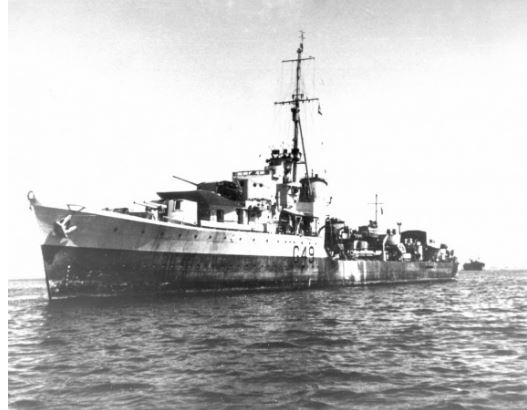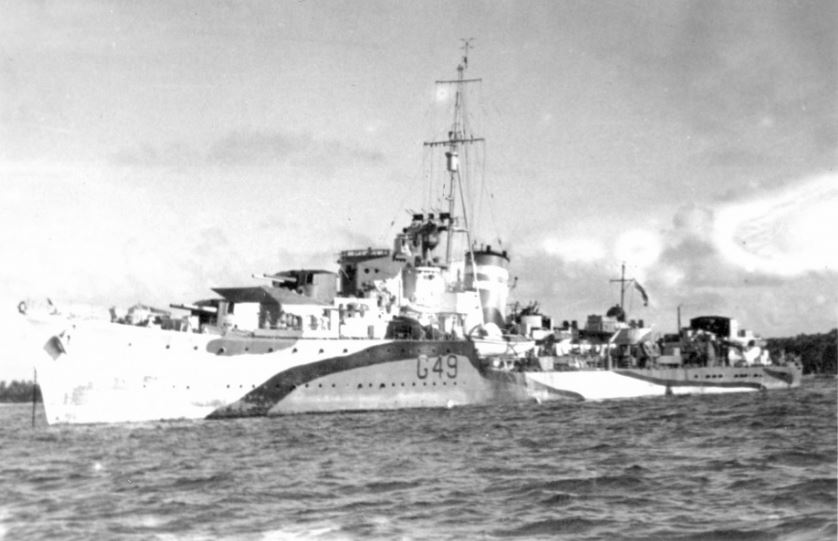HMAS Norman
From Our Contribution
Remarks
Following trials, Norman proceeded to Scapa Flow. In October 1941 she conveyed a delegation to Murmansk in Russia. A brief period of escort duties with the Home Fleet followed. In December she returned to the Thornycroft yards at Southampton for minor modifications.
In January 1942 Norman was allocated to the Eastern Fleet and proceeded to the Indian Ocean protecting the troop convoy WS 15. In February and March 1942 Norman was mainly engaged on Indian Ocean escort duties and screening heavy units of the Eastern Fleet. She became part of a large fleet to protect Ceylon, including HMAS Vampire. For three days and two nights the Eastern Fleet cruised south of Ceylon without sighting enemy units before returning to Addu Atoll. Shortly afterwards a Japanese force was sighted 360 miles (600 km) off the Ceylon coast. This was the carrier task force under the command of Vice Admiral Nagumo, comprising six aircraft carriers, four battleships, three cruisers and twelve destroyers. Substantially the same force that had carried out the attacks on Pearl Harbor and Darwin.
On 5 April the Eastern Fleet sortied from Addu Atoll, with Norman operating as part of the screen. It remained at sea between the Maldives and Ceylon, avoiding the superior enemy forces by day and seeking opportunities to attack by air at night, until 8 April, when it returned to Addu Atoll. On 8 Apr 1942, the Japanese were in complete naval control of the Bay of Bengal and able to assert superiority in waters south of Ceylon, causing the withdrawl of the Eastern Fleet from Addu Atoll. Norman resumed escort duties, arriving in Bombay at the close of April 1942.
In May it was decided to reinforce the Mediterranean Fleet from forces available in the Indian Ocean for the passage of two Malta convoys, one from Gibraltar, the other from Egypt. The forces sent to cover the eastern convoy (westbound) included the four Australian N Class destroyers Norman, Napier, Nestor and Nizam. The eastern convoy was forced to return to Egypt as a result of the large Italian fleet operations, constant air attack and a shortage of fuel. One cruiser, three destroyers, including HMAS Nestor and two merchant ships were sunk and several ships including three cruisers were damaged durignthe convoy attempt. Counter attack in the air sank the Italian cruiser Trento and severely damaged other units of the Italian fleet.
Returning to the Indian Ocean, Norman resumed escort and patrol duties. In September 1942, she took part in the second Madagascar campaign (10-29 September), which ended with the British occupation of the entire island. During October to December 1942, Norman was engaged in routine Indian Ocean escort and fleet screening duties. In January 1943 she was one of the escorts for the convoys returning 30,000 AIF troops from the Middle East to Australia. In March and April she underwent a refit at Simonstown in South Africa. From May to December 1943, Norman she was occupied escorting Indian Ocean convoys, and in August she escorted the UK to India convoy, WS 32, from the Congo River on the African west coast to Durban and thence northwards. In October she arrived in Indian waters, patrolling, escorting and exercising, and in January 1944 Norman joined Force A, arriving at Colombo late in the month.
In April 1944 Norman arrived in Australian waters for the first time, arriving in Sydney on 24 April for a refit. In July she returned to the Eastern Fleet at Trincomalee to resume escort and patrol duties in the Indian Ocean. In mid-October she participated in the attack on the Nicobar Islands. Begining with an air attack, followed by night bombardment in which Norman participated. She then returned to Trincomalee. Norman spent November and December 1944 on escort duty.
On 18 Jan 1945 Norman sailed from Trincomalee for operations on the Burmese Arakan Coast. Sister ships Napier and Nepal were already engaged in the area having taken part in the capture of Akyab, the main Japanese base. She was a part of the force that in January covered the landing of Indian troops on Ramree Island. There was little opposition following the heavy shelling and bombing of the Japanese defences. She then participated in the seizure of Cheduba Island by Royal Marines following a naval bombardment which included Norman. She continued operations in the Burma theatre, and on 30 January she and another destroyer successfully silenced Japanese field guns on Sagu Island which had repulsed at attempted landing the previous day. Norman spent February 1945 on exercises and escort duties. On 1 March she sailed for Fremantle, arriving on on 10 March and Sydney on 16 March.
On 1 Apr 1945 Norman sailed from Sydney with Napier for the Philippines to commence operations as units of the British Pacific Fleet. In mid April Norman joined Task Force 57 and was a part of the screen for the carriers conducting daily air strikes against Okinawa. and later the Sakishima Gunto area. On 22 May she was detached to escort the destroyer HMS Quilliam, which had been damaged in a collision with an aircraft carrier, to Leyte.
On 6 Jun 1945 Norman returned to Sydney and remained in port until the end of the month. On 4 July she arrived at the Manus base with the 7th Destroyer Flotilla where she assumed the role of general duty and escort destroyer. In one period in July she visited 82 ships, carrying mail and stores and transferring 221 men by jackstay. Hostilities ceased on 15 August 1945. In September Normanproceeded to Japan but arrived in Tokyo too late for the surrender ceremony. She redturned to Sydney in October 1945 and reverted to Royal navy ownership. She was sold in 1955, and in 1958 was broken up for scrap.
Battle Honours
- Indian Ocean 1941-45
- Eaast Indies 1940 - 44
- Burma 1944 - 45
- Okinawa 1945
Crew
- William Henry Knox 16 Sep 1941 - 18 Nov 1942

